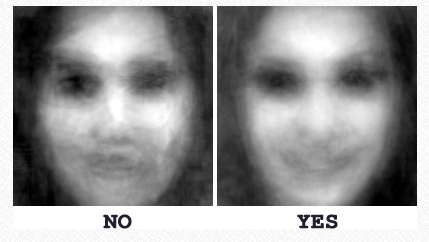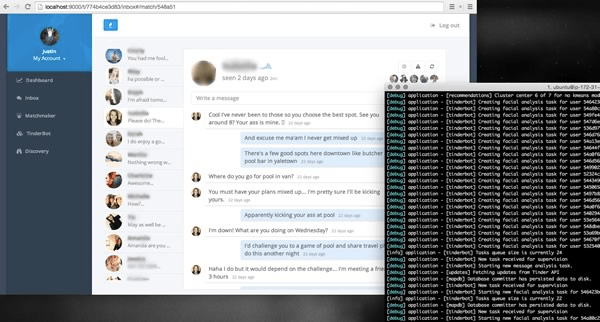Move over T Machine, there’s a new automated Tinder hack in town — and this one doesn’t just dumbly swipe right on every potential date like a drunk trying to undo their shoelaces. It’s got visual smarts, thanks to an Eigenfaces algorithm that analyzes the facial features of each potential mate — and then likes or dislikes each based on your own previously expressed aesthetic choices. So basically: Hello Tinder + machine learning!
The software was created by Vancouver-based developer Justin Long. Detailing his project in a blog Long notes that he got “fed up” with all that manual swiping on Tinder — so decided there had to be a smarter, tech-powered fix for the tedium/sore thumbs. And one that didn’t just indiscriminately swipe, like T Machine et al. Hence he decided to add in facial recognition algorithms for more intelligent auto-sorting.
He writes that he built the first version, which he called Tinderbox, in three weeks, pulling on the Tinder APIs to recreate the Tinder app experience in a browser. Faces are cropped out of suitable profile pictures (smaller shots won’t work of course) and are then compared with an average face, representing the sum of the human user’s aesthetic choices. And yes these amalgams definitely check the ‘uncanny valley’ box…

Long notes that the user is required to make 60 yes/no choices before the bot has enough data to choose on your behalf — after which it can be on full Tinder “auto pilot”. Yikes!
But wait, there’s more! The Tinder bot can even start conversations with potential mates too — thanks to Long implementing natural language processing tech to power a conversation starter messaging feature, and help the user weed out matches who aren’t actually into them (perhaps because they were swiping right on everyone).
He writes:
Using StanfordNLP, the bot analyzes the sentiment of each chat response and classifies it as positive or negative. Using a “message tree”… the bot selects from pre-programmed chat messages as a response based on the sender’s sentiment. This continues up to 3 replies until the user is notified that a chat is ready to enter. The advantage of this? It removes the time involved in filtering new Tinder matches since a lot of people tend to drop off and “go dark” early in the process. Extended conversation is a strong indicator of interest.
Which does really rather pose the question of what happens if the Tinderbox algorithm encounters itself in a chat? Would the machine-to-machine exchange result in algorithmic love at first byte? Or would the feedback loop cause some kind of marginless error that takes Tinderbox out of action, leaving its human instigator forced to resort back to thumbs? We can but speculate…
(Update: Asked about this Long confirms he hasn’t (yet) tried algo-on-algo but says his “gut feeling is it will burn out rather quickly into stalemate” because he notes messages are pre-set — not auto-generated. And indeed he adds that failure to swap out these pre-set messages when he let a female friend try out the bot resulted in 40 men on Tinder being asked if “They could teach a guy to bake and all that”. Which just goes to show that human error can be hugely amplified by automation.)
One thing is for sure, a future of algorithmic dating is going to involve some pretty weird conversation openers. (Although mate-seeking humans let loose on dating apps are quite capable of that on their own, as Tinderfessions amply illustrates.)
What happened with Long’s relationship with Tinderbox? Turns out they went steady for a while, and things were good. Too good. To the point of it becoming a distraction. So he’s now kicked the algorithmic habit. But does say he went on “at least 10 dates” based off of Tinderbox’s choices. And in “a couple cases” says he had “follow-ups” — and is apparently “still seeing one person”, despite revealing his machine-powered pick-up methods to her. That must have been a fascinating conversation*…
Long adds:
The bot is amazingly effective. I would estimate an accuracy of up to 70% in its selections – though there may be a hindsight bias. Using a brand new account, I did a quick test to see how quickly the bot could get results. In 48 hours, the bot registered 21 matches (starting all of those conversations), made 4 extended conversations, and the bot itself made over 300 moves. A “move” is any step the bot makes in either sending a message or making a swipe. And in that time I barely needed to touch the app. I also created a dashboard to give me an overview of my metrics.
Reader, he even created a dashboard. That really is taking procreation evolution to the next level.
So there you have it. Whether Long would have found the same partner by thumb power alone, or stumbled upon a different human is, alas, an unanswerable question. There’s no algorithm for parsing parallel universes — yet.
The code for Tinderbox has been made available for personal use and modification on Github. Long says he doesn’t currently have any plans to pursue the project commercially. Undoubtedly some other developer will.
Update: Interestingly, Long tells TechCrunch, too many faces (around 300+) pushes the algorithm to breaking point — “the ‘yes’ model and the ‘no’ model seem to converge,” he says, adding: “It would indicate that there are limits to the algorithm, and a different strategy is needed for the long-term.”
Another problem for algorithm-powered mate-matching is the prevalence of Instagram et al filters making it harder for the bot to distinguish between faces properly.
“The bot produced a full spectrum of looks, and the reason for this is because the Eigenfaces algorithm mostly focuses on facial features rather than skin color or body type. That’s not to say I didn’t look into adding those features into the algorithm. The problem was mostly due to how so many photos used many filters, probably from Instagram, and it was difficult to normalize them. If I had more time and had to do it all over again, I’d probably be a little more comprehensive,” he adds.
He also told TechCrunch what his girlfriend had to say when she found out the algorithmic truth. “She actually thought it was really cool! What helped the most was that this wasn’t a ‘swipe for all’ scenario, and the bot was meant to seek out others just how I would pick them myself,” he says, adding: “To be honest, I was surprised that many women had a positive reaction to it. It is something novel and actually meant to ‘be a part of myself’. After matches have been filtered, Tinderbox is entirely meant to be passed over to the user. I think it would be rather dystopian if a person couldn’t ask for their own date.”
*A note on Long’s Github page includes the helpful caveat: “Since it is a tool that automates a lot of the Tinder experience, be forewarned not everyone appreciates being met through a robot.”
